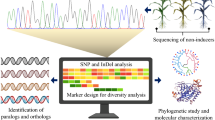Abstract
Cytogenetical and molecular studies in Argemone mexicana Lin. (2n = 28) and A.ochroleuca ssp. ochroleuca Sweet. (2n = 56) showed exclusive bivalent pairing at meiois; their triploid hybrid had, univalents, bivalents and trivalents; autotetraploid of diploid A. mexicana had bivalents and quadrivalents and polyhaploid of A. ochroleuca showed bivalency. Random amplified polymorphic DNA analyses did not support the autotetraploid nature of A. ochroleuca. The dendrogram based on pair-wise genetic similarity coefficients showed distinct grouping of two species into two clusters. The conflicting data are resolved by deducing that sufficient similarities existed between one of the ochroleuca and the diploid species genome; the remainder of the ochroleuca genome had homologous chromosomes. Apparently, A. ochroleuca carried enough cryptic intergenomic homologies which ordinarily remained unexposed. In ochroleuca ‘hemizygous-ineffective’ mechanism is suggested. Further a diploidizing genetic mechanism is envisaged. Alternatively an acute propensity to preferential pairing caused bivalent formation. Such a system or systems caused meiotic isolation of various genomes and instituted normal fertility. Thus repression of genetic control is of evolutionary significance in the creation of reproductive isolation and sterility barriers for further speciation. The segmental allotetraploid nature of A. ochroleuca is inferred.



Similar content being viewed by others
References
Bouvet JM, Fontaine C, Sanou H, Cardi C. An analysis of the pattern of genetic variation in Vitellaria paradoxa using RAPD markets. Agroforest Syst. 2004;60:61–9.
Chaturvedi M, Datta K, Pal M. Pollen anomaly - a clue to natural hybridity in Argemone (Papaveraceae). Grana. 1999;38:339–42.
Doyle JJ, Doyle JL. Isolation of plant DNA from fresh tissue. Focus. 1990;12:13–5.
Fu C, Qiu Y, Kong H. RAPD analysis for genetic diversity in Chagium smyrnioides (Apiaceae) an endangered plant. Bot Bull Acad Sin. 2003;44:13–8.
Gustine DL, Huff DR. Genetic variation within and among white clover populations from managed permanent pastures of the northeastern US. Crop Sci. 1999;39:524–30.
Jauhar PP. Genetic regulation of diploid-like chromosome pairing in the hexaploid species, Festuca arundinacea Schreb. and F. rubra L. (Gramineae). Chromosoma. 1975;52:363–82.
Jauhar PP. Genetic control of chromosome behavior Implications in evolution, crop improvement, and human biology. Nucleus. 2010;53:3–12.
Jayram K, Prasad MNV. Genetic diversity in Oroxylum indicum (L) Vent (Bignoniaceae) a vulnerable medicinal plant by random amplified polymorphic DNA marker. Afr J Biotechnol. 2008;7:254–62.
Kshetrapal S, Jain U, Tanwar TC. Anatomical study in the genus Argemone. Bulletin Bot Survey India. 1984;26:164–6.
Machua J, Muturi G, Gicheru J. Genetic diversity within Brachylaena Huillensis (O Hoffim) populations in Kenya implications for conservation of a wood Carving tree. J Discov Innov. 2004;19:32–6.
Malhotra SK. Natural hybrid between A. mexicana and A. ochroleuca. Cur Sci. 1960;29:282.
Malik CP, Grover IS. Argemone subfusiformis Ownbey (Papaveraceae) – a new record for India. Indian Forester. 1969;95:480–1.
Malik CP, Grover IS. The Genus Argemone II Cytogenetic Relationships of A ochroleuca ssp ochroleuca (2n = 56) and some diploid (2n = 28) Argemone Species. Theor Appl Genet. 1973;43:329–34.
Malik CP, Thomas PT. Chromosomal polymorphism in Festuca arundinacea. Chromosoma. 1966;18:1–10.
McDonald A. Plantae alpinae novae Mexicanae Ae subalpina (Papaveraceae). Bittonia. 1991;43:120–2.
Ownbey GB. Monograph of the genus Argemone for North America and the West Indies. Mem Torrey Bot Club. 1958;21:1–159.
Ownbey GB. The genus Argemone in South America and Hawaii. Brittionia. 1961;13:91–109.
Schwarzbach AE, Kadereit JW. Phylogeny of prickly poppies Argemone (papaveraceae) and the evolution of morphological and alkaloid characters based on ITS nrDNA sequence variation. Plant Syst Evol. 1999;218:257–79.
Sneath PHA, Sokal RR. The principles and practices of numerical classification Numerical taxonomy (Freeman Pbl. San Francisco) USA 1973.
Venktesh CS. Argemone ochroleuca ssp. ochroleuca A new record for India. Curr Sci. 1962;31:250–1.
Author information
Authors and Affiliations
Corresponding author
Rights and permissions
About this article
Cite this article
Karnawat, M., Malik, C.P. Determination of nature of polyploidy in Argemone ochroleuca ssp. ochroleuca Sweet. Nucleus 54, 153–158 (2011). https://doi.org/10.1007/s13237-011-0045-x
Received:
Published:
Issue Date:
DOI: https://doi.org/10.1007/s13237-011-0045-x




